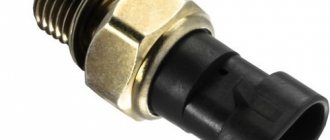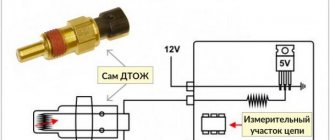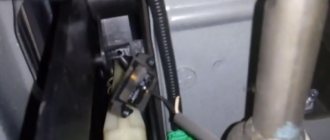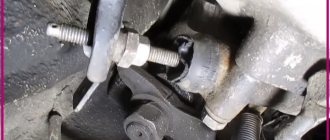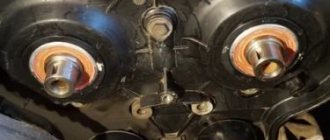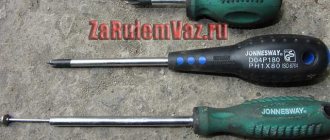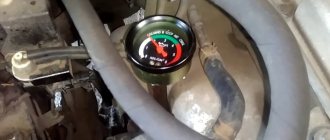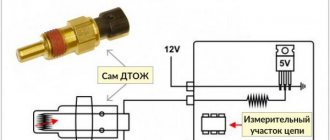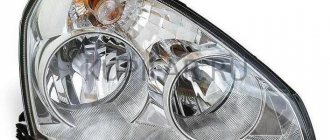The popular Priora was designed in the spirit of the times, so the computer even controls such a unit as the clutch. The electronics do not control the process of turning the clutch on and off, but the clutch sensor on the Priora, installed under the clutch pedal, collects information about the position of the pedal. This data enters the electronic engine control unit and is used to optimize engine operation depending on the driving mode, and also makes it possible to use cruise control on the car.
How does the electronic engine management system work?
The electronic engine control unit controls most of the vehicle's components, excluding the steering and suspension. ECU programs include presets (tables), according to which optimal operating modes are calculated. Many sensors installed on the car read information about speed, movement, engine speed, activated mechanisms and units. Based on the tables, the ECU changes the ignition mode, turns on additional functions and regulates the composition and amount of the air-fuel mixture entering the cylinders.
Functions of the Priora clutch sensor
Data about the current mode of the clutch mechanism is important for engine control. If the clutch is open, it is necessary to reduce the fuel supply and reduce engine speed. It is optimal to do this in accordance with the current speed of the vehicle, without switching to idle mode. A driver, especially an inexperienced one, may make mistakes, which leads to increased load on the engine and clutch. The on-board computer, based on the readings of the clutch sensor, adjusts the engine operating mode, setting the optimal speed. Also, the clutch sensor on the Priora, in combination with the speed sensor, allows the computer to evaluate the performance of the unit and signal problems.
Installing a clutch sensor on a Priora allowed:
- reduce fuel consumption;
- make driving easier and more enjoyable;
- control the serviceability of the coupling;
- extend clutch life.
Therefore, the serviceability of the sensor affects the service life of the units, fuel consumption and is extremely important for the correct operation of the ECU.
Operating principle of the Priora clutch sensor
What is a Priora clutch sensor? The operating principle of the device is no different from a simple limit switch. When the pedal is not pressed and the clutch is engaged, the sensor contacts are open. When you press the clutch drive, the limit switch closes, sending a signal to the computer to separate the clutch disc and basket.
The clutch sensor is installed on the pedal mounting assembly so that the tip of the pedal touches the limit switch.
The sensor design is simple and reliable, but this does not exclude the possibility of breakdowns and malfunctions in its operation.
What are clutch sensors
For the engine to function in the optimal, best mode, it is necessary to control the condition of the clutch. When the unit is open, fuel is supplied in a smaller volume - the speed decreases.
Changes must correspond to the current speed; gear changes should not be carried out at idle. Such errors are typical for novice motorists or due to inattention; as a result, the motor and clutch experience abnormal loads and conditions and wear out faster. A side effect is an increase in exhaust emissions, so the clutch pedal sensor is one of the conditions for environmental friendliness (Euro toxicity standards, etc.).
The sensor (sensor, detector, limit switch, switch) of the clutch mechanism, also known as an electronic pedal, is needed so that the on-board computer (electrical control unit - ECU) reads information from it to control the internal combustion engine modes, determining and setting the optimal speed.
The electronics send impulses to the control system, which synchronizes the rotation of the crankshaft and primary shaft on the gearbox.
Clutch sensors are installed on both robotic gearboxes (automatic transmissions) and mechanical ones; they are not fundamentally different in their tasks, but their appearance and location differ significantly. In the first case, the ECU also reads the speed of the vehicle and some other factors, because of this, when the accelerator is pressed sharply, the system engages a gear with higher speeds and simultaneously increases them at the engine.
In automatic transmissions, the device is called a gear shift position sensor (not pedal) or simply a selector, as well as an “inhibitor”, and its description is a separate topic.
We will look at the pedal sensor specifically, that is, on a manual transmission; we will describe the automatic transmission briefly so that the reader understands the difference.
Tasks of the clutch pedal position detector
Let's clarify and group the functions:
- Fuel consumption is reduced as the internal combustion engine operates more correctly. Accordingly, oil consumption and emissions are reduced;
- driving is more comfortable (no jerking);
- the condition of the coupling is monitored;
- the service life of the gearbox, clutch assembly, and therefore the entire system increases, since these mechanisms directly or indirectly affect almost all processes.
A significant plus for the car owner is savings, since fuel costs are reduced and the service life of the mechanisms is increased.
Signs of a malfunction of the Priora clutch sensor
This sensor is connected to the car’s ECU; accordingly, the first sign of a breakdown is the reaction of the control unit in the form of the appearance of a corresponding signal on the dashboard. The nature of movement and operation of the car engine also changes. Symptoms of malfunction are as follows:
- The “Check Engine” light is on;
- when starting to move the car jerks;
- When you press the clutch pedal, the engine speed rises or falls sharply.
The warning lamp on the instrument panel lights up if the computer does not receive a signal from the clutch sensor within 2 seconds from the moment the vehicle starts moving or within 4 seconds when changing speed while the vehicle is moving.
The sensor has a very simple design, so there are few reasons for failure:
- faulty sensor contacts;
- break or short circuit of the wires going to the sensor;
- Incorrect installation of the sensor near the pedal.
Important: the clutch sensor is installed only on Priora models equipped with an electronic throttle. If the car is equipped with a regular throttle cable, there is no clutch sensor. Also, when replacing a sensor, you should focus on its model. Sensors from all-wheel drive VAZ and Priora sensors are not interchangeable.
Replacing the Priora clutch pedal sensor, photo and video instructions
On the presented Lada Priora, the following problem occurred: when you pressed the clutch pedal while changing gears, noticeable jerks appeared, and the Check Engine light came on on the dashboard.
The owner went to a service station, where diagnostics revealed a faulty clutch sensor, or rather a break in its wire. The service offered to replace it, which would involve dismantling the pedal assembly, but they did not have this sensor in stock. On the way to the store, I decided to replace it myself. What is a clutch sensor used for?
In a car equipped with an electronic gas pedal, the clutch sensor helps the ECU make the correct decision when the car is moving; a smooth start from a place depends on its operation; it eliminates jerks when changing gears. If the sensor is faulty or its wire is broken, it begins to twitch when the speed changes. The sensations are similar to when at first speed we raise the speed to maximum, and then suddenly release the gas pedal.
Replacing the Priora clutch sensor
To dismantle the Priora clutch sensor, you just need to unscrew the two screws holding it to the clutch pedal. But to get to them, you need to do a lot of operations. Removing the Priora clutch sensor is done as follows:
After removing the sensor, you can replace it with a new one or repair it.
The sensor is installed like this:
- secure the sensor with self-tapping screws;
- install the rubber clutch pedal cover;
- install frill;
- secure the windshield wiper blades.
Repair of the Priora clutch sensor
Often, sensor malfunctions can be easily resolved without replacing it.
First you need to check whether the sensor end reaches the clutch pedal pusher. If the pusher does not press on the limit switch, it is necessary to adjust the position of the sensor relative to the pedal.
Another common failure is a break in the wires going to the sensor contacts. This malfunction can be easily detected by checking that the wires are securely fixed with your fingers. To fix this problem, you need a soldering iron, solder and rosin. When the sensor is removed from the car, soldering wires to its contacts is not difficult.
If the sensor wires are not broken and the limit switch reaches the pusher, the problem may be a faulty sensor contact or a broken limit switch. They may oxidize, become deformed or break. The functionality of the contacts can be checked using a multimeter. To do this, you need to connect the device to the sensor terminals and check the change in resistance between them when you press the limit switch.
Oxidized contacts can be cleaned, restoring the functionality of the sensor. If this does not work, it should be replaced. The price of this part is low, and you can buy it at most auto stores.
Replaced the clutch sensor. This sensor is located in the cabin, directly above the clutch pedal. You can say at its axis of rotation (or whatever it is called), in short, where it is attached.
This is what the clutch sensor looks like with a wire and a connector.
As far as I know and understand, this sensor is only installed on cars with E-gas, but there are no throttle position and idle speed sensors. But all this is answered by E-gas. If I'm wrong, please correct me. The first symptom is that the clutch sensor is dead - Jackie Chan came to visit me. To be honest, I didn’t even do the diagnostics. The most interesting thing is that the check light came on after about 400-500 km, when it started to become really dull. It’s interesting that the sensor started to go dull yesterday. The next day I start it, drive and everything is fine. But over time, everything is new again. Or it could all stop before I got home, and the next day it would start drizzling again in the morning. In short, nothing is clear))).
And it slows down in the following way: when changing gears (let’s say from 3 to 4), you squeeze the clutch and the rpms immediately jump by about 500 (maybe a little more). Or in another way: you are accelerating or driving at one speed and decided to switch, and then when you press the clutch the car itself picks up speed and immediately drops it. But if you first release the gas, then wait 1-2 seconds. and squeeze the clutch, the revs do not jump. And not long before the death of this sensor there was one strange thing. The car started to jerk at low speeds, about 1000-1200 rpm, no matter what gear. I read about this crap on the Internet and decided to change this sensor. By that time, my check had not yet cleared. As soon as I bought the sensor, I drove 300-400 meters away from the market and the check light came on.
And here's a little story about the search for the sensor. The first thing I did was call the store where they sell spare parts from the factory. They said he wasn't there. They constantly give applications for it, but don’t deliver it. Then I called the 2nd office. to dealers. The first one said that it was there. Price 500 rubles, replacement also 500 rubles. Honestly, it’s expensive, both for the sensor and for replacing it. At the 2nd dealer, the price of the sensor is 400 rubles, replacement is 300 rubles. This is more modest.
This is what the sensor itself looks like. The spring is attached differently, not like in the picture. One side to the pedal, and the other somewhere else))
And this is the inside of the sensor. Agree, even 400 rubles is expensive for this.
Still, I decided to go to the market and ask there. Still, it should be cheaper on the market than from the officials. I arrived at the market and approached the first seller I came across. He says that there is and immediately asks how much it costs in other places. I answered him that I didn’t know, so I approached him first. He gives me 500 rubles. I go further, and there: - What kind of sensor is this? — This is the first time I’ve heard about such a sensor. - And what car? This sensor is the same for all cars, including Kalina, Granta, Priora and Samara. This is what I assume about the chepyrka. He should probably be there too. In the 2nd photo you can see the catalog number. - Or here’s an example: “What kind of car?” “On a grant.” “We don’t have anything on a grant.” I wonder if if I had said to a Priora or a Kalina, this sensor would have suddenly appeared? And if I had said something bad, the sellers would have been in a panic, they would have looked at me like I was an idiot, and they would have started to argue and prove that there was no such sensor there. And yet I found it cheaper. For 250 rubles. Of course, the seller asked me which car. Anyway. I decided to change it myself, suffered, suffered, and scored. I went to the nearest service center and changed it for 200 rubles. The service also heard about the sensor for the first time. I showed him the sensor where it is. He took it off quickly, one might say, but it took him a long time to put it back.
Now the car started to drive normally and stopped jerking at low speeds.
Modern cars are equipped with special electronic clutch pedals, which ensure ease of gear shifting and normalization of the transition to a new engine operating mode.
Like any other element of the system, the pedal has a sensor responsible for transmitting data to the control unit. Irregularities in its operation can lead to surges in speed and unstable operation of the power unit. Therefore, even a new Granta clutch sensor that has failed may require immediate repair.
Lada Kalina Hatchback ◅ Alfa Kalina ▻ › Logbook › Replaced the clutch pedal position sensor
This gadget is installed on Russian cars with E-gas for a reason: it greatly facilitates the starting process, eliminates dips and (if the gasket between the pedals and steering wheel is in order) jerks when changing gears, and reduces, albeit slightly, fuel consumption.
The sensor transmits signals to the engine controller to engage or disengage the clutch and helps regulate speed. A malfunction of the clutch pedal position sensor is an unpleasant thing, but in principle you can drive with it. I went
